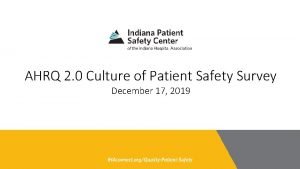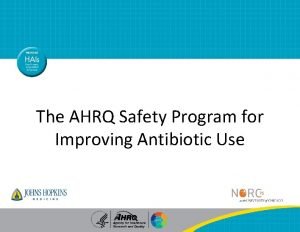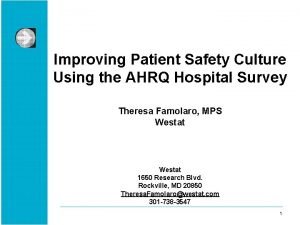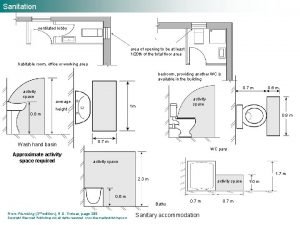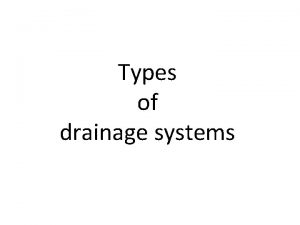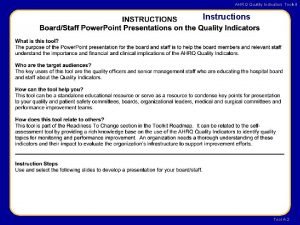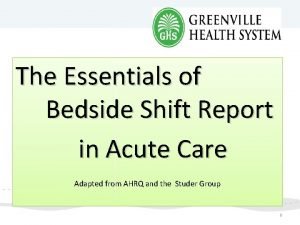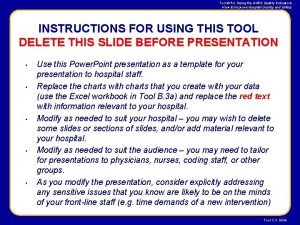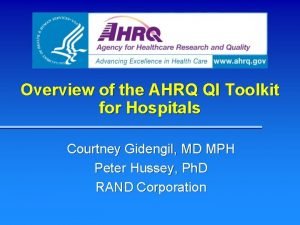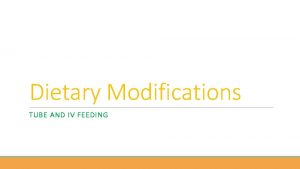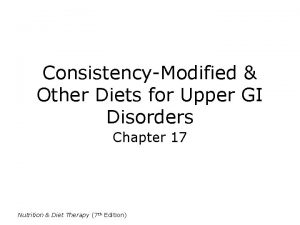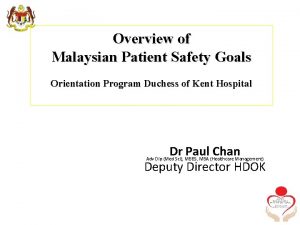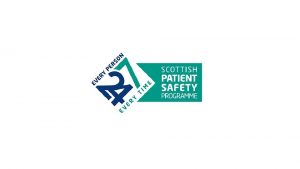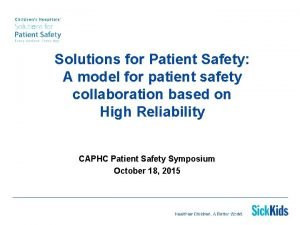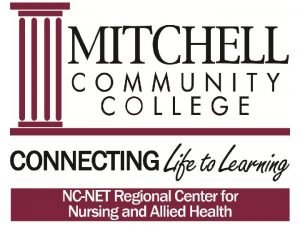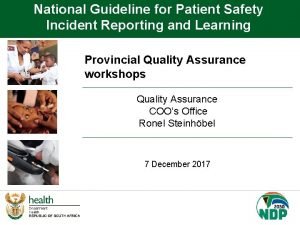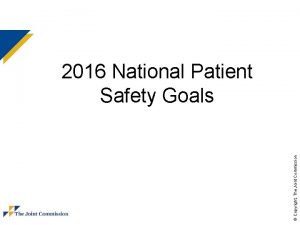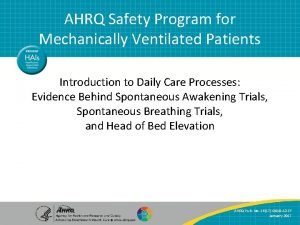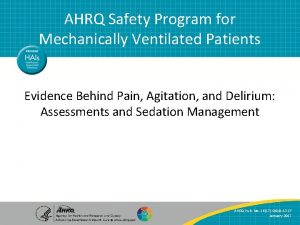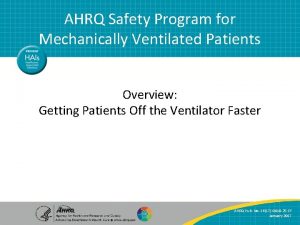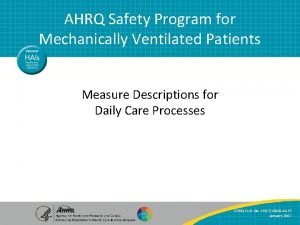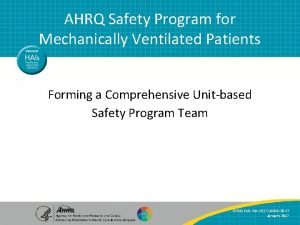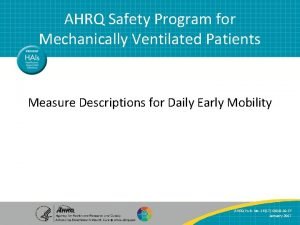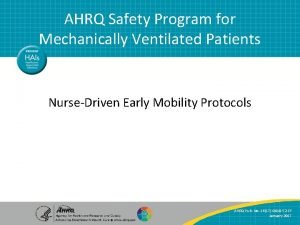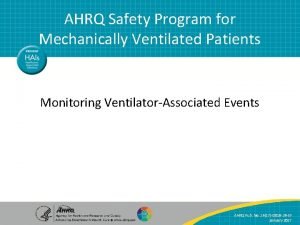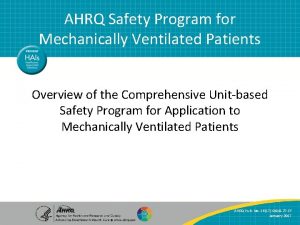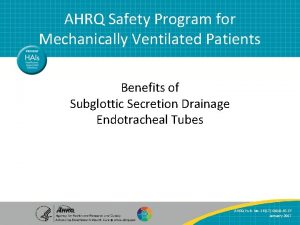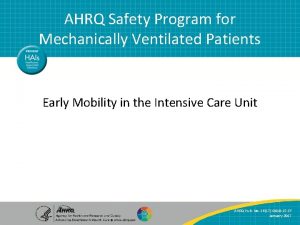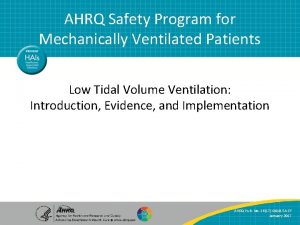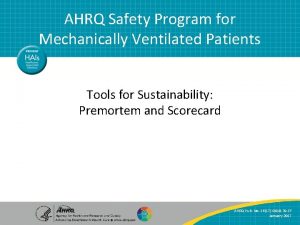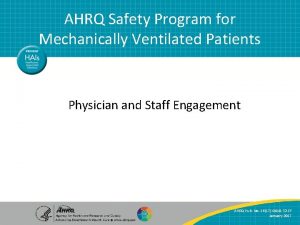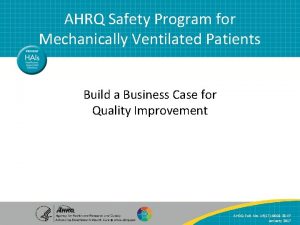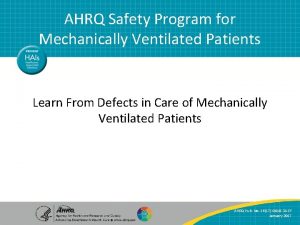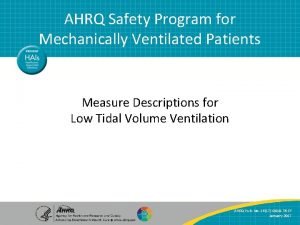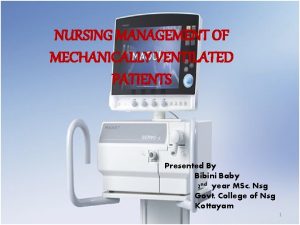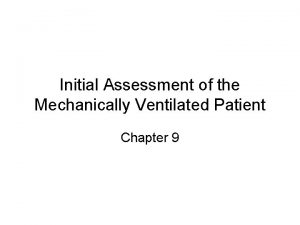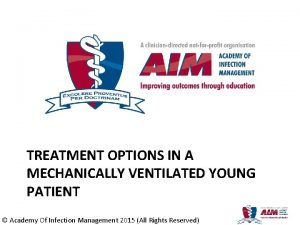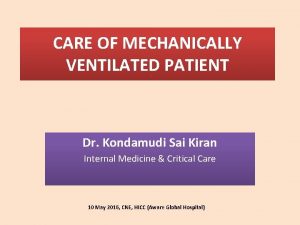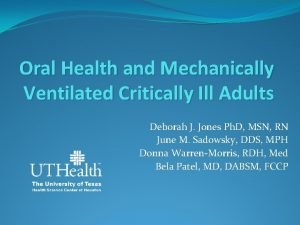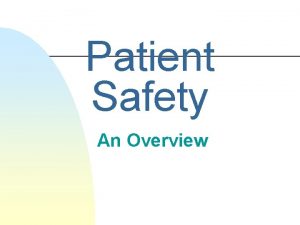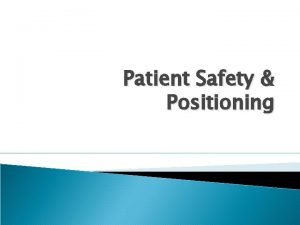AHRQ Safety Program for Mechanically Ventilated Patients Patient

























- Slides: 25

AHRQ Safety Program for Mechanically Ventilated Patients Patient and Family Involvement in Care of Mechanically Ventilated Patients AHRQ Safety Program for Mechanically Ventilated Patients AHRQ Pub. No. 16(17)-0018 -37 -EF January 2017 Patient/Family Involvement 1

Learning Objectives After this session, you will be able to— • Describe the importance of family involvement in the critical care setting • Understand the benefits of shared decision making • Identify key components of patient-centered care • Apply the understanding of basic human needs to improve patient centered care AHRQ Safety Program for Mechanically Ventilated Patients Patient/Family Involvement 2

FAMILY INVOLVEMENT AHRQ Safety Program for Mechanically Ventilated Patients Patient/Family Involvement 3

Why Are You Doing This? Imagine your mother, father, loved one in a critical care setting. What would you want for them? For you as a family member? AHRQ Safety Program for Mechanically Ventilated Patients Patient/Family Involvement 4

Family Stress in the Intensive Care Unit 1 • Family members of patients in the intensive care unit (ICU) may experience fear, anxiety, depression, and post-traumatic stress • Nurses and physicians do not always accurately predict the needs of patients’ families • Individualized instruction, with proactive assessment of family needs in a manner that promotes the inclusion of patients’ family members in bedside care, may help fulfill the needs of patients’ families and optimize family members’ adaptation to critical illness 1. Davidson JE. Family-centered care: Meeting the needs of patients’ families and helping families adapt to critical illness. Crit Care Nurse. 2009 Jun; 29(3): 28 -34. PMID: 19487778. AHRQ Safety Program for Mechanically Ventilated Patients Patient/Family Involvement 5

What Could Have Improved the Experience? • What if the nurse had invited you to help? • What if you built a relationship where you were a trusted member of the health care team? AHRQ Safety Program for Mechanically Ventilated Patients Patient/Family Involvement 6

Development of Family Involvement Menu 2 -4 • The Family Involvement Menu was developed using results from nurse exercises and family surveys • Nursing staff were educated on the availability and intended use of the menu • The Family Involvement Menu was displayed on a reusable white board in each patient room to encourage its use 2. Wyskiel RM, Weeks, K, Marsteller, JA. Inviting families to participate in care: A family involvement menu. Jt Comm J Qual Improv. 2015 Jan; 41(1): 43 -6. PMID: 25976723. 3. Mahoney D. Nurturing a collaborative culture. Partners. Oct-Nov 2014. Gordon and Betty Moore Foundation. https: //www. moore. org/docs/default-source/default-documentlibrary/nurturing-a-collaborative-culture. pdf? sfvrsn=2. Accessed Aug 26, 2015. 4. Wyskiel RM, Chang BH, Alday AA, et al. Towards expanding the acute care team: learning how to involve families in care processes. Fam Syst Health. 2015 Sep; 33(3): 242 -9. PMID: 26148096. AHRQ Safety Program for Mechanically Ventilated Patients Patient/Family Involvement 7

Family Involvement Menu Implementation strategies • What might your team put on the menu? Developed by Rhonda Wyskiel, R. N. , Johns Hopkins Armstrong Institute AHRQ Safety Program for Mechanically Ventilated Patients Patient/Family Involvement 8

Themes of Family Involvement 5 • Enacting care – Participating in providing care structured around the patient and family member allows family to feel more involved, giving them a focus and purpose. • Connecting with sick relative – Providing care not only helps family members access the patient's world and contribute to their comfort and well-being, it also lets patients feel a personal connection with family members. • Partnering with nurses – The initiative of families providing some care improves communication with the nurses. Communication is an essential element in meeting families’ needs and is therefore of particular importance in a familycentered care initiative. 5. Mitchell M, Chaboyer W. Family centered care—a way to connect patients, families and nurses in critical care: a qualitative study using telephone interviews. Intensive Crit Care Nurs. 2010 Jun; 26(3): 154 -60. PMID: 20430621. AHRQ Safety Program for Mechanically Ventilated Patients Patient/Family Involvement 9

Shared Decision Making Critical Care Medicine Journal of the Society of Critical Care Medicine Clinical Practice Guidelines for Support of the Family in the Patient-Centered Intensive Care Unit Davidson et al. 2007 “…endorsement of a shared decision-making model, early and repeated care conferencing to reduce family stress and improve consistency in communication, honoring culturally appropriate requests for truth-telling and informed refusal, spiritual support, staff education and debriefing to minimize the impact of family interactions on staff health, family presence at both rounds and resuscitation, open flexible visitation, way-finding and family-friendly signage, and family support before, during, and after a death. ” 6 6. Davidson JE, Powers K, Kamyar M, et al. Clinical practice guidelines for support of the family in the patient-centered intensive care unit: American College of Critical Care Medicine Task Force 2004 -2005. Crit Care Med. 2007 Feb; 35(2): 60522. PMID: 17205007. AHRQ Safety Program for Mechanically Ventilated Patients Patient/Family Involvement 10

Remember Your Own Experience Think back to your initial thought of your mother, father, or loved one in a critical care setting and what you would want for them and for yourself, as a family member. Remember, promoting family involvement in your ICU can help promote the change we want to see in patient-centered care. AHRQ Safety Program for Mechanically Ventilated Patients Patient/Family Involvement 11

PATIENT-CENTERED CARE AHRQ Safety Program for Mechanically Ventilated Patients Patient/Family Involvement 12

Empathy Is Important “I have learned that people will forget what you said, people will forget what you did, but people will never forget how you made them feel. ” Photo: Adria Richards / CC BY 2. 0 – Maya Angelou AHRQ Safety Program for Mechanically Ventilated Patients Patient/Family Involvement 13

Patient-Centered Care (PCC) • A multidimensional approach for improving care 7 • Dimensions include: 8 -10 – – – Respecting patient needs, values, and preferences Focusing on the whole person Offering emotional support and alleviating physical discomfort Communicating adequately, sharing information, providing education Strengthening the patient-provider relationship, including family and friends coordinating care across settings Patient engagement and empowerment 7. Institute of Medicine. Crossing the quality chasm: a new health system for the 21 st century. Washington, DC: The National Academies Press; 2001. 8. Gerteis M, ed. Through the patient’s eyes: Understanding and promoting patient-centered care. San Francisco, CA: Jossey-Bass; 1993. 9. Davis K, Schoenbaum SC, Audet AM. A 2020 Vision of patient-centered primary care. J Gen Intern Med. 2005 Oct; 20(10): 953 -7. PMID: 16191145. 10, Silow-Carroll S, Alteras T, Stepnick L. Patient-centered care for underserved populations: definition and best practices. Prepared by the Economic and Social Research Institute for the W. K. Kellogg Foundation. Washington, DC. January 2006. AHRQ Safety Program for Mechanically Ventilated Patients Patient/Family Involvement 14

What Do You Have in Place Currently? • What are current PCC practices? • What PCC practices or behaviors have you witnessed or participated in? • Any practices/behaviors as either active or passive engagement? AHRQ Safety Program for Mechanically Ventilated Patients Patient/Family Involvement 15

Health System–Level Applications for PCC 11 • Patient and family engagement/advisory groups • Tailoring of health care documents with consideration for health literacy, language, and cultural competency • Visiting hours • Services quality • Attention to patient-centered outcomes such as quality-of-life measures and patient experience • Provision of information on performance measures to consumers 11. Asha S, Mary CB, Cooper LA. Patient centeredness, cultural competence and healthcare quality. J Natl Med Assoc. 2008 Nov; 100(11): 1275 -85. PMID: 19024223. AHRQ Safety Program for Mechanically Ventilated Patients Patient/Family Involvement 16

From the Patient’s Perspective… …receiving acute care services is a challenging life experience. 12 -16 • Patients are acutely ill, vulnerable, anxious, and sometimes in pain • There are unfamiliar surroundings, and new health care team to interact with and trust • There are multiple medical interventions, some with substantial physical discomfort and risk • Patients receive directions and information from many people 12. Levinson W, Shojania KG. Bad experiences in the hospital: the stories keep coming. BMJ Qual Saf. 2011 Nov; 20(11): 911 -13. PMID: 21964611. 13. Coulter A, Cleary PD. Patients’ experiences with hospital care in five countries. Health Aff (Millwood). 2001 May-Jun; 20(3): 244 -52. PMID: 11585173. 14. Francis JJ, Pankratz VS, Huddleston JM. Patient satisfaction associated with correct identification of physician's photographs. Mayo Clin Proc. 2001 Jun; 76(6): 604 -8. PMID: 11393499. 15. Arora V, Gangireddy S, Mehrotra A, et al. Ability of hospitalized patients to identify their inhospital physicians. Arch Intern Med. 2009 Jan 26; 169(2): 199 -205. PMID: 19171817. 16. Villette M. For want of a four-cent pull chain. BMJ Qual Saf. 2011 Nov; 20(11): 986 -90. PMID: 21921089. AHRQ Safety Program for Mechanically Ventilated Patients Patient/Family Involvement 17

Meeting Basic Needs Patients are very vulnerable in the acute care setting. Both physical and emotional support are needed. Basic needs include pain control, warmth, food, and sleep. • Pain control remains a main concern for patients • Sleep deprivation can increase morbidity and influence recovery • Sleep disturbance in the critical care setting has been associated with prolonged length of stay, increased mechanical ventilation duration, emotional distress, and delirium AHRQ Safety Program for Mechanically Ventilated Patients Patient/Family Involvement 18

Respect and Dignity 17 What does it mean in the critical care setting? • Treatment with respect and dignity is a foundational aspect of patient- and family-centered care • Better understanding of what it encompasses within the critical care setting is needed 17. Aboumatar H, Forbes L, Branyon E, et al. Understanding treatment with respect and dignity in the intensive care unit. Narrat Inq Bioeth. 2015 5(1 A): 55 A-67 A. PMID: 25772730. AHRQ Safety Program for Mechanically Ventilated Patients Patient/Family Involvement 19

Types of Treatment 17 Treatment as a Human Being Treatment as a Unique Individual Treatment as Someone Entitled to Professional Patient Care Responsiveness and rapport Treatment With Sensitivity to the Patient’s Vulnerability Offering introductions and greetings Treating patient as an important and valuable person Attending to basic bodily concerns (modesty, toileting, pain, and comfort) Facilitating ability to control Caring/positive attitude, aspects of care and make demeanor, body language choices Updating patients on their status and care plan Treating patient as an equal Recognizing individual preferences Interacting properly with professionals and patients and families during rounds Information exchange a. Orientation/telling b. Explaining/educating c. Listening d. Inviting questions and feedback Orienting patients and families to the environment (machines, alarms) Interacting considerately with critically ill patients 17. Aboumatar H, Forbes L, Branyon E, et al. Understanding treatment with respect and dignity in the intensive care unit. Narrat Inq Bioeth. 2015 5(1 A): 55 A-67 A. PMID: 25772730. AHRQ Safety Program for Mechanically Ventilated Patients Patient/Family Involvement 20

Questions? AHRQ Safety Program for Mechanically Ventilated Patients Patient/Family Involvement 21

References 1. Davidson JE. Family-centered care: Meeting the needs of patients’ families and helping families adapt to critical illness. Crit Care Nurse. 2009 Jun; 29(3): 28 -34. PMID: 19487778. 2. Wyskiel RM, Weeks, K, Marsteller, JA. Inviting families to participate in care: A family involvement menu. Jt Comm J Qual Improv. 2015 Jan; 41(1): 43 -6. PMID: 25976723. 3. Mahoney D. Nurturing a collaborative culture. Partners Oct-Nov 2014. Gordon and Betty Moore Foundation. https: //www. moore. org/docs/default-source/default-documentlibrary/nurturing-a-collaborative-culture. pdf? sfvrsn=2. Accessed Aug 26, 2015. 4. Wyskiel RM, Chang BH, Alday AA, et al. Towards expanding the acute care team: learning how to involve families in care processes. Fam Syst Health. 2015 Sep; 33(3): 242 -9. PMID: 26148096. AHRQ Safety Program for Mechanically Ventilated Patients Patient/Family Involvement 22

References 5. Mitchell M, Chaboyer W. Family centered care—a way to connect patients, families and nurses in critical care: a qualitative study using telephone interviews. Intensive Crit Care Nurs. 2010 Jun; 26(3): 154 -60. PMID: 20430621. 6. Davidson JE, Powers K, Kamyar M, et al. Clinical practice guidelines for support of the family in the patient-centered intensive care unit: American College of Critical Care Medicine Task Force 2004 -2005. Crit Care Med. 2007 Feb; 35(2): 605 -22. PMID: 17205007. 7. Institute of Medicine. Crossing the quality chasm: a new health system for the 21 st century. Washington, DC: The National Academies Press; 2001. 8. Gerteis M, ed. Through the patient’s eyes: Understanding and promoting patient-centered care. San Francisco, CA: Jossey-Bass; 1993. AHRQ Safety Program for Mechanically Ventilated Patients Patient/Family Involvement 23

References 9. Davis K, Schoenbaum SC, Audet AM. A 2020 Vision of patient-centered primary care. J Gen Intern Med. 2005 Oct; 20(10): 953 -7. PMID: 16191145. 10. Silow-Carroll S, Alteras T, Stepnick L. Patient-centered care for underserved populations: definition and best practices. Prepared by the Economic and Social Research Institute for the W. K. Kellogg Foundation. Washington, DC. January 2006. 11. Saha S, Mary CB, Cooper LA. Patient centeredness, cultural competence and healthcare quality. J Natl Med Assoc. 2008 Nov; 100(11): 1275 -85. PMID: 19024223. 12. Levinson W, Shojania KG. Bad experiences in the hospital: the stories keep coming. BMJ Qual Saf. 2011 Nov; 20(11): 911 -13. PMID: 21964611. 13. Coulter A, Cleary PD. Patients’ experiences with hospital care in five countries. Health Aff (Millwood). 2001 May-Jun; 20(3): 244 -52. PMID: 11585173. AHRQ Safety Program for Mechanically Ventilated Patients Patient/Family Involvement 24

References 14. Francis JJ, Pankratz VS, Huddleston JM. Patient satisfaction associated with correct identification of physician's photographs. Mayo Clin Proc. 2001 Jun; 76(6): 604 -8. PMID: 11393499. 15. Arora V, Gangireddy S, Mehrotra A, et al. Ability of hospitalized patients to identify their in-hospital physicians. Arch Intern Med. 2009 Jan 26; 169(2): 199 -205. PMID: 19171817. 16. Villette M. For want of a four-cent pull chain. BMJ Qual Saf. 2011 Nov; 20(11): 986 -90. PMID: 21921089. 17. Aboumatar H, Forbes L, Branyon E, et al. Understanding treatment with respect and dignity in the intensive care unit. Narrat Inq Bioeth. 2015 5(1 A): 55 A-67 A. PMID: 25772730. AHRQ Safety Program for Mechanically Ventilated Patients Patient/Family Involvement 25
 Ahrq patient safety survey
Ahrq patient safety survey Ahrq antibiotic stewardship
Ahrq antibiotic stewardship Ahrq safety culture survey
Ahrq safety culture survey Sanisnake
Sanisnake 2 pipe system
2 pipe system Ahrq quality indicators
Ahrq quality indicators Ahrq bedside shift report
Ahrq bedside shift report Ahrq quality indicators toolkit
Ahrq quality indicators toolkit Ahrq qi
Ahrq qi Dod patient safety program
Dod patient safety program Mechanically inclined meaning
Mechanically inclined meaning Example of altered feeding routes
Example of altered feeding routes Dietary adjustments after a gastrectomy are influenced by
Dietary adjustments after a gastrectomy are influenced by One point perspective from plan and elevation
One point perspective from plan and elevation Mechanical aided repertory
Mechanical aided repertory What are sediments?
What are sediments? Mechanically cleaned bar screen
Mechanically cleaned bar screen 13 malaysian safety goals
13 malaysian safety goals Jack in the box
Jack in the box Patient 2 patient
Patient 2 patient Scottish patient safety programme
Scottish patient safety programme Solutions for patient safety bundles
Solutions for patient safety bundles National patient safety goals 2012
National patient safety goals 2012 National guideline for patient safety incident
National guideline for patient safety incident Learn from patient safety events
Learn from patient safety events Joint commission national patient safety goals 2016
Joint commission national patient safety goals 2016
